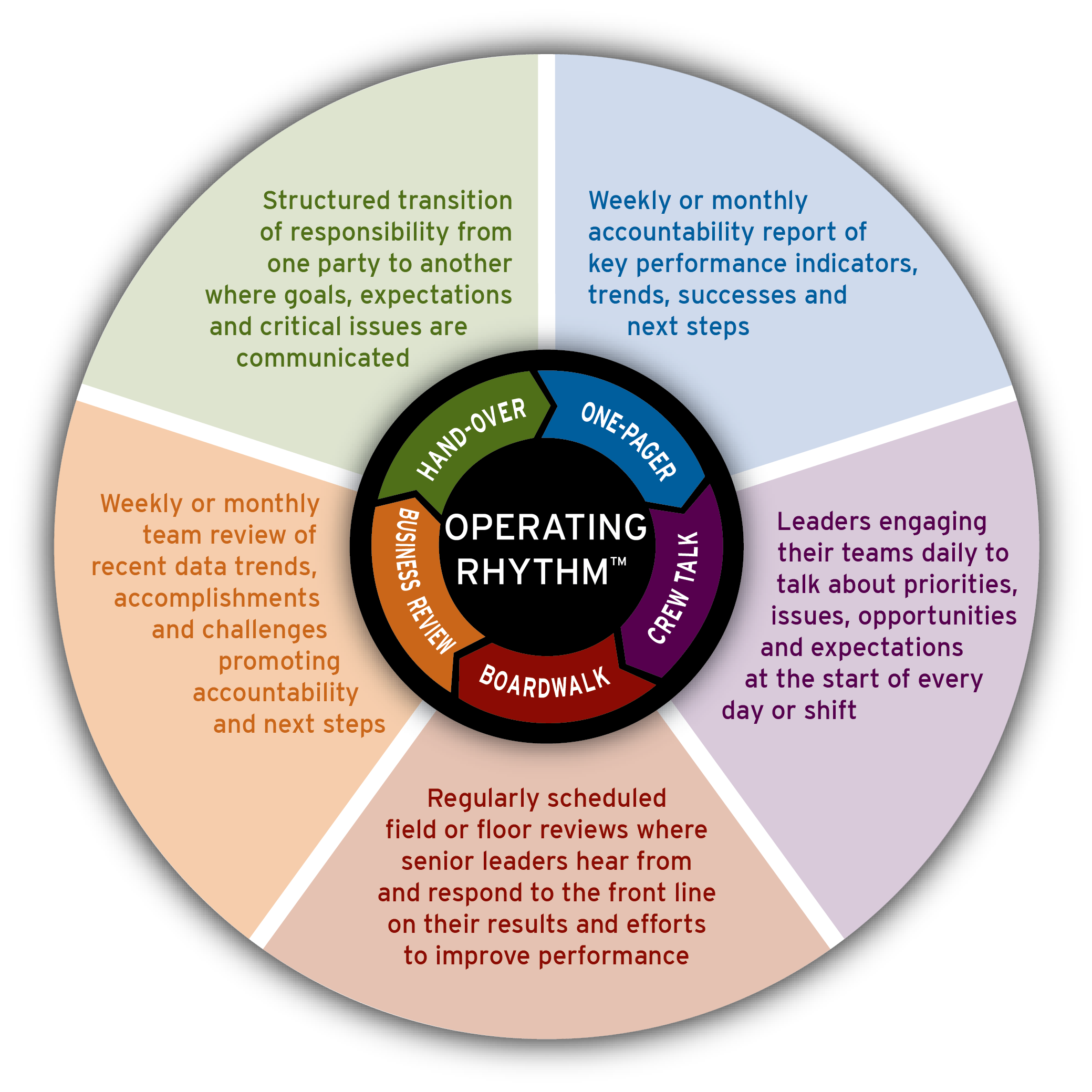By Han Juch and Jerry Weisenfelder

In a recent article on Operating Rhythm, we established that developing an effective Operating Rhythm™ within an organization, beyond the usual meeting cadence, is hindered by existing culture, busyness, lack of awareness and resistance to change. Indeed, setting up Operating Rhythm is not straight forward.
A good Operating Rhythm™ is not simply about setting up a frequency of meetings with the usual metrics and action list. Indeed, most organisations can do that by themselves without much help. Rather, an effective Operating Rhythm requires a change of behaviour, conversation, language and mindset of both leaders and participants.
In our experience of 35 years, we at RLG know that it takes at least the following five steps to implement an effective Operating Rhythm (for now disregarding a diagnostic assessment, a preparation and alignment phase, and the transition stage after a typical RLG Operating Rhythm implementation project):
- An overall design or overhaul of the current set of key meetings within the organisation. This includes an integrative approach in view of interfaces, timing, frequencies, attendance and set-up possibilities. One can choose to pilot with a part of the organisation. We normally advise to start with the daily, shift and business review meetings, and then extend the approach to other meetings at a later stage. Sequencing of meetings is important. The selected Operating Rhythm meetings should have revised terms of reference (TOR) explaining the what, why, how and who of these meetings, ideally using standard templates. Don’t be afraid to start from scratch – often, an organisation’s meetings are legacy;
- Ensuring defined mechanics for the selected Operating Rhythm meetings are in place, such as clear roles, agenda, action or promise tracking list, a proposed plan and a relevant performance report. Regarding the latter we advise short 1-page reports (one pagers, scorecards), with clear KPI’s, trends, actions to close gaps and recognition for positive results and behaviours. We aim for a variety of meeting set ups beyond the traditional boardroom meeting tables dominated with PowerPoints presentations, so for example having Boardwalks and Stand up meetings are highly desirable;
- Educate participants and leaders of these Operating Rhythm meetings on topics of generative conversations and accountability. For many who have spoken so long in non-accountable and non-generative language, the content of these workshops are often a big eye-opener and a large step to make. People must learn how to formulate a promise or how to request an action, how to close actions in a proper way, how to ask for support and how to recognize people. Yes, this all sounds a bit basic, but it is our experience a major gap holding many organizations back. Simply, individuals, and especially leaders, need to understand and use accountability and generative language to achieve consistently high results through their teams;
- Introduce and then strengthen, using a coaching approach, the Operating Rhythm facilitation and leadership techniques for maximum effectiveness. We often do this in phases, starting with high priority meetings and leaders, then working across the organization. As one can expect, the high frequency meetings are established and improved faster, becoming models for low-frequency and subsequent meetings. In the meantime, we support individuals in preparing for their new or improved Operating Rhythm meetings, especially when setting up something entirely new, like a Boardwalk, or preparing a one-pager scorecard. We maintain importance to build both capability and confidence, and model desired behaviours. Through observation and feedback, during and after an Operating Rhythm meeting, we coach key players on improving their practices.
- Help the organisation to manage their Operating Rhythm quality (while keeping the conversations during meetings as dynamic as intended). Most organisations don’t ‘manage’ their meetings, they simply attend them. As a result, conversation absent of the accountability and generative language dominates, and meetings wander, often without full engagement, structure, purpose and results. Indeed, how many people say, “we have too many unproductive meetings!” Operating Rhythm management is an opportunity to improve this, to transform meetings into high points, enjoyable and productive. Often, one of our RLG Performance Coaches will mentor a selected number of people in Operating Rhythm management as one of their secondary roles.
Certainly, designing and implementing an effective Operating Rhythm takes time and effort, yet it generates huge payoff for the organization and the individual. If you are interested in learning more about Operating Rhythm, visit our Operating Rhythm page to watch videos or read more. We welcome you to reach out and talk to us too.